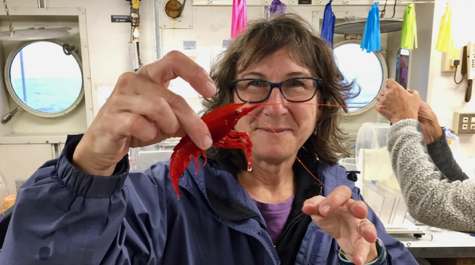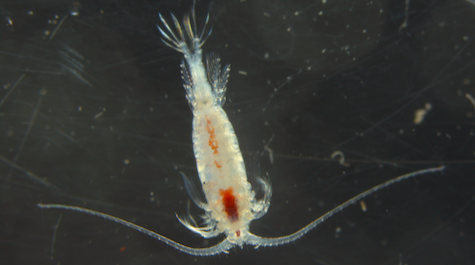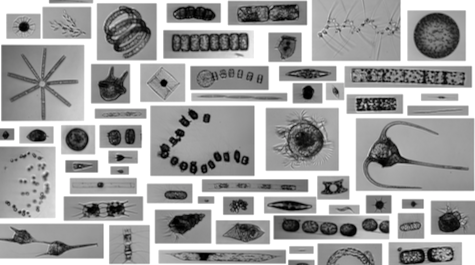VIMS scientist helps lead NASA-funded ocean expedition
Project uses ships and satellites to determine fate of main greenhouse gas
Professor Deborah Steinberg of William & Mary’s Virginia Institute of Marine Science set sail in early August aboard a major NASA-funded research expedition to the North Pacific Ocean.
The goal of the 6-week cruise—which involves more than 100 scientists and crew from 20 institutions worldwide—is to combine data from ships and satellites to better understand and predict what happens to atmospheric carbon dioxide once it has entered the marine realm.
Knowing the fate of this oceanic CO2 is important because carbon that reaches the deep sea contributes nothing to global warming and can remain there for tens to thousands of years. Says Steinberg, “Transfer of organic carbon to the deep sea represents a potentially large sink for carbon dioxide—the main greenhouse gas implicated in global warming.”
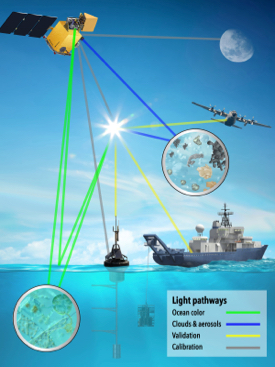 The project—dubbed EXPORTS for EXport Processes in the Ocean from Remote Sensing—is the first time that researchers will simultaneously study all aspects of this complex, planetary process. Doing so will require the full suite of modern scientific instrumentation, from space-based sensors to high-tech sampling nets and remotely operated underwater vehicles.
The project—dubbed EXPORTS for EXport Processes in the Ocean from Remote Sensing—is the first time that researchers will simultaneously study all aspects of this complex, planetary process. Doing so will require the full suite of modern scientific instrumentation, from space-based sensors to high-tech sampling nets and remotely operated underwater vehicles.
Steinberg says, “We’ll be measuring all the many components of the biological pump, which is the transfer into the deep ocean of organic carbon that’s fixed in surface waters.” Fixing refers to the transformation of carbon dioxide into organic carbon through photosynthesis.
The biological pump operates through three main processes. Carbon-laden particles from the ocean’s surface sink through gravity, as happens with dead phytoplankton or feces produced by small animals called zooplankton. A daily vertical migration by some zooplankton carries ingested carbon from the surface to deeper waters. Physical processes, such as vertical ocean mixing, can also export suspended and dissolved carbon to depth.
Professor David Siegel of the University of California, Santa Barbara (UCSB), the project’s overall science lead, says “We’ve designed EXPORTS to simultaneously observe the[se] three basic mechanisms… We’re trying to better understand the biology and ecology of phytoplankton in the surface water, how those characteristics drive the transport of carbon to the twilight zone, and then what happens to the carbon in deeper water.”
The EXPORTS team will focus on quantifying the magnitude of these processes and their dependence on ecosystem characteristics. This information is needed to predict how much carbon will cycle back into the atmosphere over what time scales, or how much carbon is exported to ocean depths—crucial knowledge for guiding the human response to climate change.
Why now?
Oceanographers, including Steinberg and colleagues at VIMS, have been studying for decades the individual processes involved in the biologic pump. The reason EXPORTS is the first holistic study of the phenomenon, she says, is the sheer scale of effort required, as well as needed advancements in technology.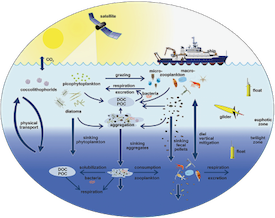
“It’s quite a feat to coordinate this many people in two ships,” says Steinberg. “It takes a long time to put a highly interdisciplinary, collaborative program like this together.” Indeed, planning for the project began as a scoping study for NASA in 2012.
The two ships—which embarked from Seattle on August 10th—are the research vessels Revelle and Sally Ride, both operated by the Scripps Institute of Oceanography. Steinberg and Dr. Jason Graf of Oregon State University are chief scientists aboard the 273-foot R/V Revelle. Chief scientists for the 238-foot R/V Sally Ride are Drs. Norm Nelson of UCSB and Mary Jane Perry of the University of Maine. Other VIMS participants in the cruise are marine technician Joe Cope and postdoctoral researcher Dr. Karen Stamieszkin.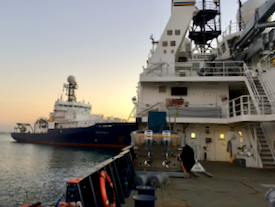
A pair of ships provides the greater spatial context needed for a comprehensive understanding of the biological pump. Paula Bontempi, program manager for Ocean Biology and Biogeochemistry at NASA Headquarters, says “By employing two ships we’ll be able to observe complex oceanographic processes that vary both in space and time that we wouldn’t be able to capture with a single ship.”
“Our team is on what we call the process-study ship,” adds Steinberg. “We’ll be doing experiments near a single station to measure the rates of all these different biological pump processes, while the other ship, the survey ship, is transecting a larger area so we can put what we’re finding into a larger spatial context.” 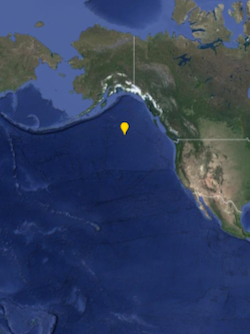 The project will tie into a greater time dimension as well—sampling from the process-study ship will be done near NOAA's Ocean Station Papa, where ships and buoys have recorded meteorological and oceanographic data since 1949. The station lies about 800 miles south of Anchorage, Alaska, and a 4-day cruise from Seattle for the EXPORTS ships.
The project will tie into a greater time dimension as well—sampling from the process-study ship will be done near NOAA's Ocean Station Papa, where ships and buoys have recorded meteorological and oceanographic data since 1949. The station lies about 800 miles south of Anchorage, Alaska, and a 4-day cruise from Seattle for the EXPORTS ships.
Researchers aboard the ships will deploy a suite of traditional and cutting-edge instruments to measure the pump’s many biological and physical components. These include an autonomous platform called a “Wirewalker” that uses wave energy to move instruments along a taut wire from the surface to 1,600 feet in depth while measuring temperature, salinity, oxygen, carbon, and chlorophyll. A remote-controlled underwater vehicle called the Seaglider will gather similar measurements, but to depths as great as 3,200 feet. 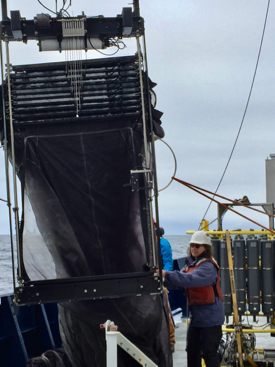 Steinberg’s team will use a MOCNESS plankton net (for Multiple Opening/Closing Net and Environmental Sensing System) to collect zooplankton from discrete depth intervals.
Steinberg’s team will use a MOCNESS plankton net (for Multiple Opening/Closing Net and Environmental Sensing System) to collect zooplankton from discrete depth intervals.
In the shipboard labs, the scientists will use genomic sequencers to assess the composition of the phytoplankton, zooplankton, bacterial, and archaeal communities. They will also use new imaging tools, including a high throughput microscope called the Imaging FlowCytobot, to provide real-time, high-resolution images of billions of individual phytoplankton. The Underwater Vision Profiler will measure the sizes of sinking aggregates and collect images of zooplankton.
Optical instruments atop the ship’s superstructure will measure the ocean’s color at very high spectral resolution, from ultraviolet to infrared wavelengths, to help identify the distinct “signatures” or colors of light absorbed and scattered by different species of phytoplankton. This will allow scientists to develop algorithms for future satellite ocean-color missions such as NASA’s Plankton, Aerosol, Cloud, ocean Ecosystem (PACE) mission. From space, PACE will use similar optical instruments to distinguish the type and amount of phytoplankton present in the ocean.
Steinberg stresses that tying the global surface view available from satellites to the deeper view available from ships and underwater sensors is what sets EXPORTS apart. While satellites can only peer 30 to 90 feet beneath the waves, ship-deployed sensors can sense all the way to the seafloor, which at the study site lies almost 14,000 feet down.
“It’s really important that we’ll be tying our work to satellites,” says Steinberg. “In addition to the data gathered by our net tows and submerged sensors, we’ll have people onboard doing lots of bio-optical measurements, and there are satellites already up there that we’ll be tying those measurements into. Our ultimate goal is to be able to measure the biological pump from space, to give us a global perspective of its magnitude and dynamics.”


